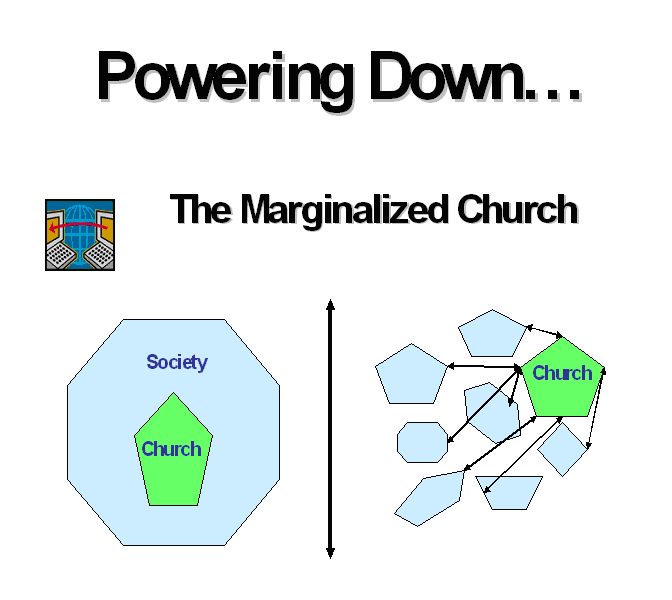Treasure in Clay Jars
Lesson One (alternative A) Feb. 12, 2006
Finding Our Way in the Story in Which We Find Ourselves
Outcome Objectives
- Group will examine a Christian worldview that endures through every shift and change in cultural worldviews.
- Group will identify ways in which the revelation of God provides disciples of Jesus with a biblical worldview that is based on seeing the world the way God sees it.
- Group will distinguish the difference between a modern worldview and a post-modern worldview.
- Group will identify how influence and power were vested in Christendom from the fourth century through the twentieth century.
- Group will examine the tendency of congregations to entrench in a world of modernity rather than courageously take the gospel to the prevailing culture.
Opening Discussion
[Note: Rather than go over all these in detail, be selective in what discussions are most interesting and beneficial in your group. The opening discussion should only last for about one-quarter of your time together.]
- Observe that ones worldview includes the presuppositions, beliefs, and values that shape how one see reality and determines how one will think and act, yet Scripture endures through every shift and change in cultural worldviews.
- The apostle Paul addresses the importance of living in whatever worldview one finds oneself as disciples of Jesus, with a biblical worldview based on seeing the world as God sees it.
- Christians are to test every worldview according to Romans 12:1-2, and to base their worldview in Christ (the renewing of your mind). Discussion question Have you ever changed your mind? Give an example of a time you changed your mind about something and it influenced what you did thereafter.
- 1 Corinthians 1:18-25 contrasts the wisdom of God with the wisdom on humanity. Verse 31 instructs Christians to boast only in the Lord.
- 2 Corinthians 5:16 declares a Christian worldview, So from now on we regard no one from a worldly point of view. Through we once regarded Christ in this way, we do so no longer. Therefore, if anyone is in Christ, he is a new creation; the old has gone, the new has come!
- Observe that scripture provides disciples of Jesus with a biblical worldview. Naturally Christians live in the world, but we are not to be of the world. How are disciples of Jesus to exist in the world, remain true to God, but not isolate themselves from living out the gospel in the culture in which they find themselves?
- Historians describe four major worldviews: 1) classic, 2) middle-ages, 3)modern and 4) postmodern, which have formed worldviews throughout the history of humankind in Western Civilization. To investigate how contemporary Christians will live out the mission of God in the culture in which we find ourselves, it is important to review the two most recent worldviews: modern and postmodern
- Define a modern worldview by giving examples such as [note that a modern worldview isnt really so modern!]:
- The Enlightenment (18th century) ushered in a worldview of rational thought and reason. Education, knowledge, literacy, belief, progress and scientific reasoning replaced the irrationality, superstition, and tyranny of the middle ages.
- The Restoration Movement began in the early 19th century firmly rooted in rationality, reasoning, and right beliefs. Early on, the movement invited all people to come and reason together. Since reason and science were seen as the ultimate absolutes, leaders of the Restoration Movement (Campbell, Lipscomb) made a case for a rational and reasonable basis for gospel and religion.
- Churches of Christ that emerged from the Restoration Movement interacted successfully with the modern worldview in early America. They were successful on the American frontier, emphasized Bible study, biblical preaching, and scripture memorization. Rational thought, biblical literacy, and an emphasis of always going back to the Bible were the hallmarks of the movement. Compare this to the worldview of the Founding Fathers who worked to establish a reasonable and rational set of laws and constitutional government in America.
- Define a postmodern worldview by giving examples such as:
- In the later part of the 20th century, philosophers and social scientists began to describe a worldview turning toward globalization, consumerism, fragmentation of authority, deconstruction, and relativism.
- In the modern worldview science was seen as a means to a better future. After two world wars in the 20th century, science was seen as the potential means of destruction of the human race.
- Some have described this worldview change by stating that the golden dome of rationality collapsed. No single canopy emerged to replace rationalism.
- Postmodernism rejected any single absolute, such as reason. In a world of no absolutes, diversity, tolerance, and multiculturalism carry the day.
- In postmodernism, nothing can claim to be totally absolute, but neither can anything be proven to be totally invalid. All claims are considered.
- Additional information to distinguish the difference between a modern
worldview and a post-modern worldview is available on the attached chart
(Attachment 1)
- The important thing to remember is that King David enlisted the men of Issachar because they understood the times and knew what Israel should do. (I Chronicles 12:32) As the biblical passage notes, Christians live to the glory of God, and are charged with living out the mission of God in the culture, in the dominate worldview in which they find themselves.
Exploration
- Identify the genesis of Christendom and provide a historical overview of Christendom from the 4th century through the 20th century.
- Constantine the Great, Roman emperor in the 4th century, made Christianity the religion of the state, which before that time had suffered persecution.
- Instead of martyrdom and persecution, Christians were welcomed into the center of power and influence. Cathedrals, positioned near the city center, provided clergy with a strong voice in political affairs and in all aspects of society.
- The political kingdoms of the world were equated with the spiritual kingdom of God. This is the meaning of Christendom. So, the Roman Empire became known in time as the Holy Roman Empire. In time treaties drawn up in Europe established that the religion of a territory was determined by the religion of the ruler. For seventeen centuries (4th through the 20th), Christendom enjoyed authority and significance in Western thought.
- America, founded in the dawn of the Enlightenment, in the 17th century, emphasized freedom of religion. Clergy provided an influential voice in schools, government, and commerce. Currency proclaimed In God We Trust.
- As the worldview turned toward post-modernity in the late 20th century, Christendoms voice weakened and society began to marginalize Christendom. Churches became one of many influences in society, no longer providing a sacred canopy over the state.
- Display the graphic found on Attachment 2, and invite the group to identify ways in which they observe Christendom being marginalized (pushed to the side) in the 21st century. Possible responses include banning prayer in schools, nativity scenes removed from Courthouse lawns, and the Ten Commandments removed from some public venues. How are these both a challenge and opportunity for the church?
Response
- Congregations today may reflect characteristics of modernity more than post-modernity. For more than a quarter of a century, Churches of Christ have asked questions about our identity as a movement. This period may have served as a time of forging a new missional identity for our movement. The book of Exodus tells of the people of Israel serving as slaves in Egypt for hundreds of years, and when freed by God through Moses, spent forty years wondering in the wilderness. Could it be that God was forging a new identity for his chosen people? Did he allow them to travel for years in the desert to rid themselves of their identity as slaves and take on a new identity of free people in the promised land? Could God have used the time to cause the people of Israel to claim the Spirit of God in living daily as his chosen people?
- Could it be that the cultural turning from a modern to a post-modern worldview during the past thirty or so years has forged a new missional identity for Gods people? Is our current state as failure and loss, or is the Spirit of God inviting us to rediscover a missional heart in unimagined and unexpected places.
- Consider this statement by author Alan Roxburgh: One fears that in North America, rather than hearing this call of the Spirit to embrace and listen to the voice of God in a place of strangeness, the churches are continuing to work hard at rediscovering modes of existence and symbols of power that will move them back to an imaginary center. A return to a remembered Christendom or the old detent with modernity is impossible.
Alan J. Roxburgh, The Missionary Congregation, Leadership, and Liminality, (Harrisburg, PA: Trinity Press International, 1997).
- Roxburgh challenges readers with the observation that, The only meaningful way forward lies in understanding and embracing our new position in the culture, in society. We must live with confusion and humiliation, as a hopeful people ready to discover the new things the Spirit will birth. The continued assumption of cultural symbols of power and success will only produce an inauthentic church with little gospel, much religion, and no mission.
- Respond to Roxburghs claims about the current status of congregations in a postmodern world by answering the following questions:
- Which of Roxburghs claims do you agree with?
- Which of his claims do you disagree with or challenge?
- In what ways is our congregation successfully taking the gospel to the post-modern culture?
- Where do you see the Spirit of God leading us in regards to taking the gospel to this culture?
Attachment 1
Missional Church in Post-Modernity
Understanding the Times
I Chronicles 12:32
... men of Issachar, who understood the times and knew what Israel should do. (I Chronicles 12:32) ... you can tell the weather by looking at the sky, but you are unable to read the signs of the times! (Matthew 13:6)
Attachments compiled by David W. Wray, Abilene Christian University (2005)
|
|
|
Postmodern
|
|
Organizing Principle
|
Rationality
|
Relational
|
|
Personhood
|
Individuality
|
Community
|
|
Truth
|
Propositional/Right Answers (Absolutes)
|
Experiences/Story
(Narrative)
|
|
Faith
|
Commitment to the truth of
Scripturenurture by church
|
Abstract concept, shaped by ones own
reality and understanding
|
|
Church
|
A place where something happens (Provider
of goods and services) Build it and they will come
|
Living the reign of God as a community of
disciples prayerfully joining together for missions, ministry and worship
|
|
Missions
|
Sending of missionaries to distant lands
|
Missional lives being lived by all of us
in our families, marketplaces, in every context
|
|
Family
|
Husband (father), wife (mother), marriage,
children
|
Pluralistic lifestyles (same sex
attraction, co-habitation, traditional family, etc.)
|
|
Christian Education- Bible School
|
Informational (literacy), formal
classroom, curriculum, manuals (rationality primary)
|
Relational, narrative, non-formal (small groups,
retreats, childrens musicals, Bible Time Marketplace)
|
|
|
|
|
|
Christianity
|
Christendom, Center of Power and Influence
|
Post-Christian, Marginalized, Center
moving to Africa, China
|
|
Ministry
|
Centered in congregation, led by staff
over each division
|
Every member a minister, living out
practices of Jesus in all of life.
|
|
Spiritual Formation
|
Dependent on Sermons, Sunday School, home
devotionals, Lectureships, and Christian society
|
Events (feasts, celebrations, fasts as in
O.T.), relationships, and journeying together
|
Attachment 2

|

 Story of Jack Russell welding in the mag-cell plant. [An experienced welder on first encountering a work site within a powerful magnetic field cannot accomplish seemingly simple repair work by doing the job "by the book."] What do you do when everything you know no longer works? What do you do when the world as you know it turns upside down?
Story of Jack Russell welding in the mag-cell plant. [An experienced welder on first encountering a work site within a powerful magnetic field cannot accomplish seemingly simple repair work by doing the job "by the book."] What do you do when everything you know no longer works? What do you do when the world as you know it turns upside down?




 As long as we participate in Gods mission to the world, we are always a work in progress. We are being molded and shaped by the potter. Like every good artist, we recognize in Gods work certain patterns that identify us as his work. We will consider eight of these that have something to do with being faithful participants in Gods mission in other words, these are patterns that show us to be missional. 1) Following Gods call; 2) being shaped by scripture; 3) contrasting against the culture as a different community; 4) living out Gods intent for the world; 5) worshipping God for the sake of the world; 6) Depending on Gods spirit; 7) pointing toward the kingdom; 8) shepherding leadership.
As long as we participate in Gods mission to the world, we are always a work in progress. We are being molded and shaped by the potter. Like every good artist, we recognize in Gods work certain patterns that identify us as his work. We will consider eight of these that have something to do with being faithful participants in Gods mission in other words, these are patterns that show us to be missional. 1) Following Gods call; 2) being shaped by scripture; 3) contrasting against the culture as a different community; 4) living out Gods intent for the world; 5) worshipping God for the sake of the world; 6) Depending on Gods spirit; 7) pointing toward the kingdom; 8) shepherding leadership.


